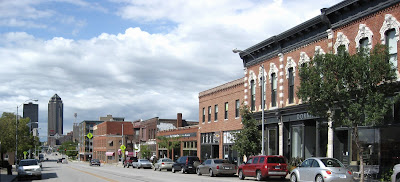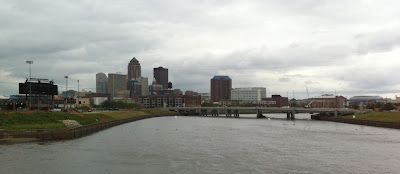
Sometimes it's a hard pill to swallow when a city has to look for direction from a smaller, younger peer. While I was in undergrad at nearby Iowa State (go Cyclones!), Des Moines was in the process of conjuring up a plan for downtown revitalization. A decade later, I might argue that the city has one of the nicest downtowns in the country for a midsize city. Greenville comes to mind as a contender but I have no personal proof.
Des Moines came up with a varied approach that included several elements which would improve several key areas in its downtown.
- A public library (by David Chipperfield) and urban park on the west end.
- Streetscaping improvements in the east village that connects downtown proper with the Capitol.
- Streetscaping also along Court Avenue (entertainment district ala Central Ave.)
- A science center to anchor the southern end of the entertainment district.
- An arena and convention center to anchor the north end near I-80.
- A riverfront park.
When all was said and done the city had spend well north of $300 million. In response, private businesses have chipped in approximately $2 billion. That's incredible in a metro area nearing 600,000 people. In all fairness, our fair city was injected by about $85 million in various small projects plus nearly $125 million for the courthouses and federal office building. Private investment has been a little less excited, investing around $100 million in residential developments. That gives a total investment package worth about $310 million, not including nearby investments such as Tingley Beach and the venerable National Hispanic Cultural Center.
So, why such a disparity between the two? Well I'm glad you asked. The Des Moines plan had support from city leadership, the community, and the business community. Downtown Des Moines was already home to several large insurance corporations with thousands of employees. City and business leaders saw this as a means to retain a fraction of the graduates the state was hemorrhaging to nearby Chicago, Minneapolis, and Denver. The businesses recognized that the city needed such urban amenities to attract and retain employees to the region. After a recent visit, I can say that the results are stunning.
This is not to say that there was not a lack of buy in from the various stakeholders here in Albuquerque. The fact that there was already 60,000 employees flooding downtown Des Moines daily was a huge factor. But Albuquerque's business community never really got behind the downtown plan in a way that encouraged businesses to move or expand there, necessarily. Blue Cross Blue Shield, Forest Service, and Fidelity Investments represent over 3,000 employees housed in shiny, new facilities on the periphery which have either expanded or relocated to the metro area ever since downtown revitalization began. Imagine what just one of those companies would have done for office vacancy rates downtown as well as demand for services in an area clinging on to its existing workforce of approximately 20,000.
Additionally, while the location of Des Moines's arena has issues, the $217 million dollar investment had a significant impact on the area. Minor league teams in addition to concerts and tournaments have injected new life into the area by bringing hundreds of thousands of spectators, annually. There was certainly a shift in attitude in the region once the facility was completed and people no longer had to make the drive to a larger city nearby for big-name entertainment. Here's where I would normally go into a long rant in support of our stellar arena plan but I'll refrain this time and, instead, leave you with a few photos from my visit.





One thing that plagues the sidewalk vitality of Des Moines is its skywalk system. Like Minneapolis, most downtown buildings are interconnected by a network of skyways, allowing employees and shoppers to get around downtown without having to be exposed to the harsh summer heat and especially, the bone-chilling, winter cold. Thus, despite having a daytime population of cities two and three times its size, the streets remain downtown Albuquerque-like quiet.
Another issue the city is facing is how to integrate the arena and convention center with the commercial core. The commercial streets, Grand, Walnut, and Court all lie in an east-west direction several blocks away to the south of the arena. Therefore, there is less opportunity for patrons to take in all that downtown has to offer. This connectivity has not been addressed aside from the waterfront park that begins to strengthen downtown connectivity in a north-south direction.
I can't begin to stress how lucky Albuquerque is to already have some of the best weather in the country. This fact alone is reason enough to push our effort toward a more walkable, bikeable city. The RailRunner, Route 66, existing convention center, movie theater, and growing residential market are a wonderful framework from which to improve our downtown. Now we really just need the willpower - and a revised plan.
